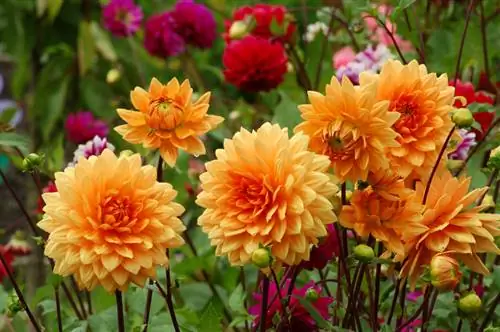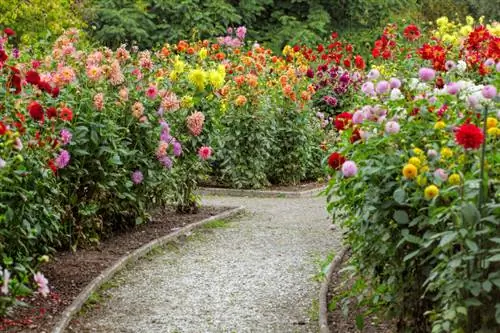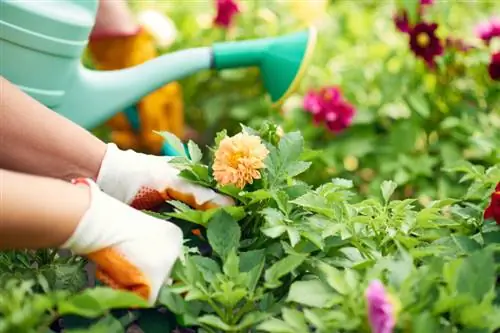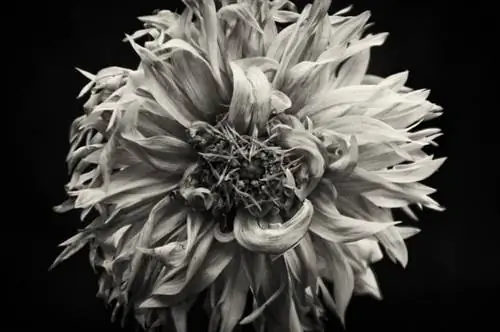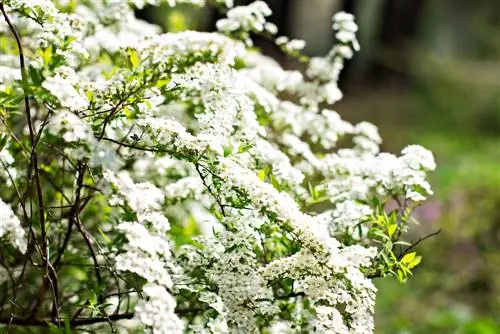- Author admin [email protected].
- Public 2023-12-25 17:45.
- Last modified 2025-01-23 11:22.
Dahlias boast magnificent flowers with artistic expression and enchanting colors. Since the georgines sprout from tubers and are not hardy, hobby gardeners deal with various questions about proper cultivation. Read tried-and-tested and substantial answers here.
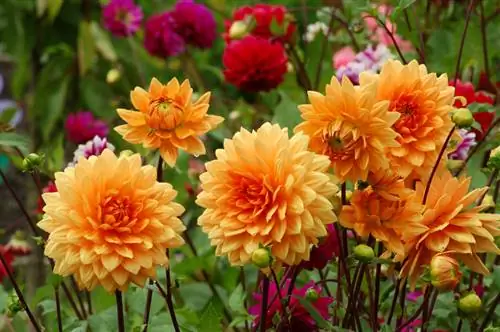
How do you properly care for dahlias?
Dahlias thrive best in a sunny, warm location with well-drained, nutrient-rich soil. They need regular watering, organic fertilizer every 14 days and weekly checks for pests or diseases to maintain their spectacular blooms well into autumn.
Planting dahlias correctly
With professional planting, you can set the course for a dreamy dahlia bloom well into autumn. Pay attention to the following process and put Georgina in the best floral mood right from the start:
- The planting time for Georgian tubers begins at the end of April
- Do not plant out advanced dahlias before mid-May
- In a sunny, warm and freshly moist location, prepare the soil until it is finely crumbly
- Work sifted compost, guano granules and horn shavings into the clod
- Plant each flower at a distance of 50-100 cm so that the top of the bulb is covered with 5 cm of soil
- Provide tall-growing varieties with a ring support or tie them to a stick
If you cultivate a dwarf dahlia in a pot or balcony box, drainage over the water drain prevents unwanted waterlogging.read more
Care tips
Georgines are hard to beat in terms of their willingness to bloom and persistence as a summer flower if they are given the following care:
- Keep dahlias constantly slightly moist and allow the substrate to dry in the meantime
- From May to July, fertilize organically every 14 days with compost (€43.00 on Amazon), guano, bark humus or horn shavings
- Clean up wilted and faded things immediately for a long flowering period
- Before the first frost, cut each flower down to 10 cm and dry upside down
Dahlias overwinter best in the dark basement at temperatures between 4 and 8 degrees Celsius. Place the tubers on a rack or in a sandbox.read more
Which location is suitable?
Native to the sun-drenched regions of Mexico, georgines develop optimally in a sunny location, without accumulating heat at midday. In semi-shady locations, the blooms usually fall short of expectations. The flower feels comfortable in an airy place as long as it has support and cannot tip over. In addition to the sunny, warm location, the soil should be well-drained, humus-rich and nutrient-rich. Dahlias never want to be confronted with permanently moist soil or even waterlogging.read more
The correct planting distance
The height of a dahlia defines the planting distance. Plant medium-sized georgines with a height of up to 120 cm at a distance of 40-60 cm. If the growth height of dahlias exceeds this, choose a distance of 100 cm from the neighbor. For dwarf dahlias and in flower boxes, a planting distance of 15-20 cm is sufficient.
What soil does the plant need?
Choose soil for georgines that is both loose and humus and rich in nutrients. A sandy-loamy structure without the risk of waterlogging is ideal. If in doubt, optimize compacted soil with sand and enrich soil that is too sandy with compost or leaf mold. A soil acidity test rounds off the choice of location in terms of its best possible properties. A score of 6.5 to 7.5 is considered ideal.
What is the best time to plant?
Dahlias do not tolerate permanent frost. Therefore, the window for planting does not open until the end of April at the earliest. To be on the safe side, we still recommend choosing a day from mid-May for the planting date. Experience has shown that once Cold Sophie has said goodbye, there is no longer any threat of ground frost. Use this caution especially when planting pre-grown georgines.read more
When is flowering time?
Georgine blooms from July to October. The flower will only last through this long phase without interruption if you take the following measures to heart:
- Pick out wilted flowers immediately
- Avoid nitrogen-based fertilizer as this only drives foliage growth
- Support tall-growing varieties right from the start, as low-lying shoots have difficulty flowering
- Break out buds in the leaf axils to save energy for the large, terminal flowers
read more
Cut dahlias correctly
With secateurs you can significantly regulate the growth and abundance of flowers of georgines. Once the young plants have become well established and have reached a height of 15-20 cm, cut off the shoot tips to encourage bushy, flower-rich growth. If more than 4 or 5 main stems are growing on a flower, cut off the excess if you want extra large flowers. During the long flowering period, withered flower heads should be cleaned out immediately to encourage fresh growth. Shorten all georgines to 10 cm shortly before the first frost before moving them to winter quarters.read more
Watering dahlias
Georgines prefer mild humidity. Therefore, water regularly without drowning a flower in water. Avoid wetting the foliage or even the flowers. If you water directly on the root area, cunning fungal spores are less likely to settle. If the lush flower in the pot on the balcony creates an idyllic ambience, the substrate should be checked daily so that it can be watered immediately if it is dry.read more
Fertilize dahlias properly
The professional supply of nutrients to georgines requires sensitivity. If the flower receives an excess of nitrogen, the leaves grow as fast as they can and the flower lags behind. You can avoid this dilemma with organic fertilizer. How to do it right:
- From May to July, fertilize every 14 days with compost and horn shavings
- Provide Georgians in the bucket with liquid, organic fertilizer
The application of fertilizer ends at the end of July at the latest so that the tuber of each flower can mature well before winter.read more
Diseases
Although lovingly cared for georgines are largely resistant to disease, the following he alth problems can occur:
- Leaf spot disease: avoid dark, wet locations
- Mildew: treat with repeated milk-water sprays (ratio 1:9)
- Bulb rot: Be sure to avoid waterlogging; create drainage in pots
Pests
A dahlia's worst enemy is slippery and extremely voracious. Unfortunately, when it comes to snails, georgines are at the top of the menu. Therefore, surround the bed with a moving barrier or a snail fence. Collect the cold-resistant pests in the early morning hours. If the infestation gets out of hand, set up crack traps with slug pellets.read more
Wintering
If the first night of frost is approaching, the tubers are picked up to move to winter quarters. Cut each flower back to a height of 10 cm and then dig it up. Any soil that is still attached is shaken off. In the following days, the georgines dry upside down until all moisture has escaped from the remaining stems. Be sure to leave this stem attached to the tuber, otherwise no shoots will form next year. This is how wintering in the cellar works:
- Fill wooden boxes with peat or sand and place the tubers in them without touching each other
- Ideally spread the flower bulbs out on a rack
- Store in a dark, cool room with temperatures between 4 and 8 degrees Celsius
If you don't have a basement, a frost-free garage or an unheated stairwell is a sensible alternative.read more
Propagate dahlias
To propagate georgines, cut the tubers in half after overwintering at the end of April. Very large onions can be cut into multiple segments as long as each piece has at least 2 eyes. Another option is to cut cuttings if you grow the georgines on the windowsill. In February/March, cut the cuttings completely from the tuber and place them in a potting soil and sand mixture so that they root by mid-May.read more
Is dahlias poisonous?
Georgines are not only completely non-toxic, but have also been used as food for generations. Unfortunately, it has been somewhat forgotten how tasty the tubers are. Not to forget the delicate aroma of the flowers, which also create a magical decoration for salads and cold buffets. So plant the flower in your family garden without worry.read more
Dahlias not blooming
If a dahlia doesn't like something, the flower signals its displeasure by refusing to bloom. With the help of structured cause research, you can quickly track down the reason so that you can quickly find a solution. You can find an overview of the most common triggers for a failure to bloom with tips here:
- Unsuitable location: move the flower to a sunny and airy place
- Drought stress: water regularly as soon as the substrate surface has dried
- Nutrient deficiency: fertilize organically every 14 days from May to July
- Nitrogen excess: avoid mineral fertilizer preparations, in favor of compost, guano and horn shavings
Also check the pH value of the soil. If the result shows a value significantly below 6.5, add a portion of vital lime or rock powder to the substrate.
Can dahlias overwinter outside?
If you enjoy the privilege of cultivating your garden in a mild-winter wine-growing region, you can dare the experiment. Before the first frost, cut each flower back to a height of 10 cm. Then pile up the georgines with a layer of leaves, straw and needles at least 30 cm high. Spread a garden fleece or bubble wrap over it. Place the georgines in the pot together with the container in the ground in a dry location, cut the flower back and spread the protection described over it.read more
Beautiful varieties
- Kaiser Wilhelm: Historical magnificent flower from 1881 with picturesque flower balls in yellow and reddish brown; Growth height 120 cm
- Bishop of Llandaff: classic among the peony-flowered georgines with bright red flowers; Growth height 90-100 cm
- Karma Serena: Fantastically beautiful flower with white, double flowers and a yellow heart; Growth height 90 cm
- Cheerio: Imposing cactus dahlia, whose crimson flowers are decorated with white tips; Growth height 80 cm
- Mount Noddy: Decorative dwarf dahlia for the flower box with red flowers; Growth height up to 30 cm
- Libretto: Impressive ruff dahlia with bicolor flowers in white and pink; Growth height 60-80 cm
- Red George: Red dwarf dahlia, with yellow flamed flowers, which was named balcony plant of the year in 2009

